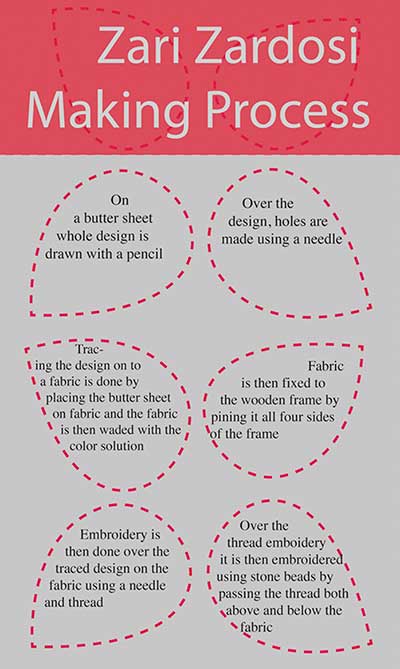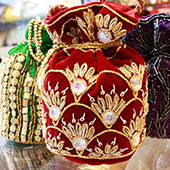Design Resource
Zari Zardozi Embroidery - Bhopal, Madhya Pradesh
Zardozi - A Style of Embroidery
by
Prof. Bibhudutta Baral and Manasa K. H.
The techniques used to create Zardozi are the same across India as the original and ancient techniques.
There are main 4 basic techniques:
1. Designing is the initial stage of the process of zardozi embroidery on a butter sheet whole design is drawn with a pencil and over the design, holes are made using a needle. In the Mughal period, designs were comprised of complex nature, floral and leaf motifs but in the modern days' contemporary methods with influence, the traditional style patterns are more preferred such as geometric stylizations of similar motifs.
2. Tracing the design onto a piece of fabric is done by placing the patterned butter paper on a flat table with the fabric underneath. Kerosene and color solution is mixed together and this solution is then dipped with a wadded cloth, which is then rubbed over the tracing sheet. This allows the ink from the sheet and the design to get discovered over the fabric.
3. Wooden frames are then made using bamboo or wooden spars to stretch the design-imprinted fabric. The size of the frame is usually depended on the size of the fabric. It is then stretched out and tightly held to give the cloth a uniform tightness. The artisans then sit around this frame to start the embroidery work.
4. Embroidery is then done over the traced design on the fabric using a needle and thread. Over that, it is then embroidered with stone beads using needle and thread. These beads are embroidered by passing the thread both above and below the fabric. It may take a minimum of 3 days to 10 days to complete a design depending on the intricacy of the design and the number of artisans working on a piece.
These embroidery works are then used to make the different products such as sling bags, handbags, men's kurtas and many other different varieties of articles.
Flow Chart:



















